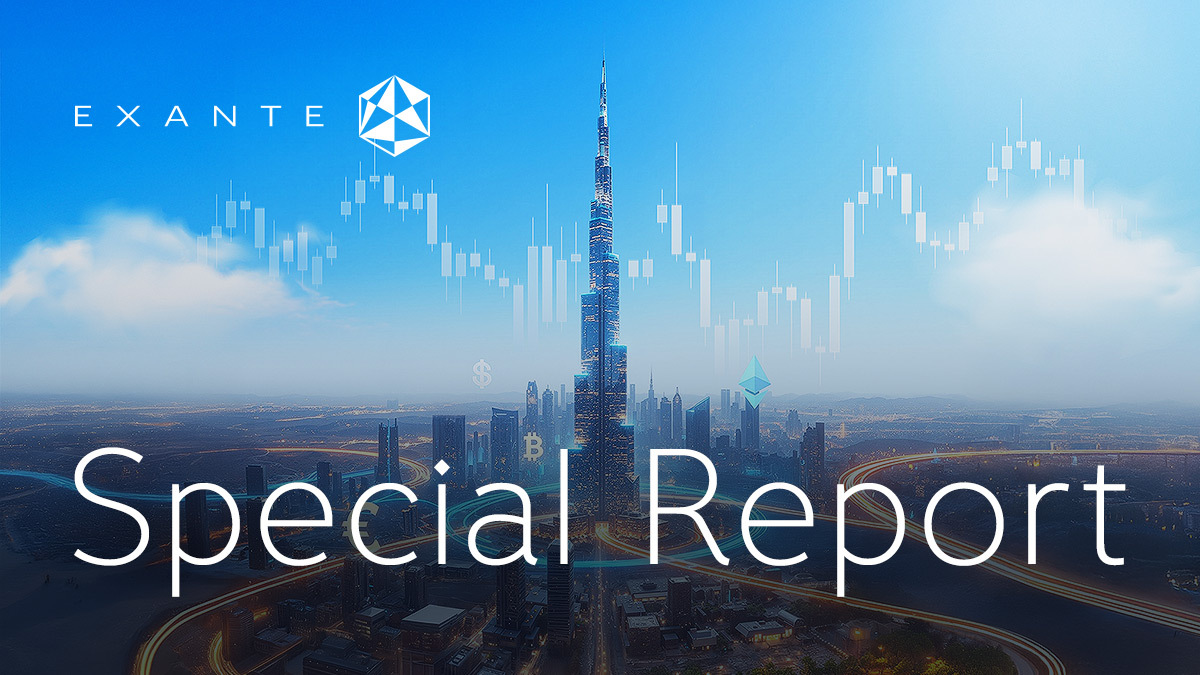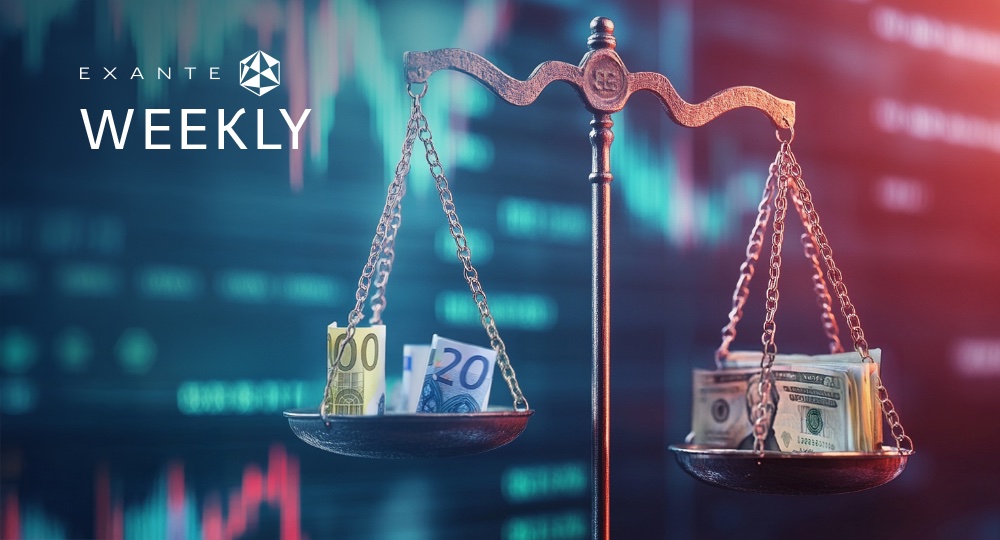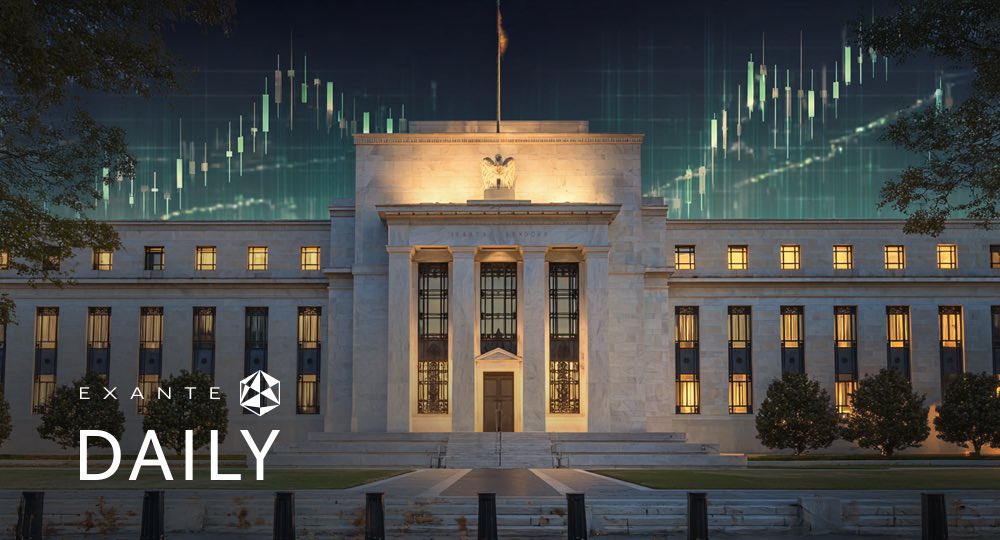
EXANTE Monthly Macro Insights
.png)
It’s been a volatile month so far for markets with uncertainty over the future pace of Fed rate rises, the impact of previous rate rises starting to hit demand and corporate earning projections, and politics confusing economic policies.
- What is the state of the US economy?
- A unanimous ECB?
- Is Europe being fooled by an Indian summer?
- The UK in defensive mode
- Cryptocurrencies new regulatory rules
- Key events in November
Markets in October
US:
S&P 500  7.63% MTD and
7.63% MTD and  19.03% YTD
19.03% YTD
Nasdaq 100  3.92% MTD and
3.92% MTD and  30.14% YTD
30.14% YTD
Dow Jones Industrial Average  10.83% MTD and
10.83% MTD and  12.39% YTD
12.39% YTD
NYSE Composite  7.86% MTD and
7.86% MTD and  15.34% YTD
15.34% YTD
Europe:
Stoxx 600  5.79% MTD and
5.79% MTD and  15.89% YTD
15.89% YTD
DAX  8.93% MTD and
8.93% MTD and  16.93% YTD
16.93% YTD
CAC 40  8.92% MTD and
8.92% MTD and  12.26% YTD
12.26% YTD
FTSE 100  2.35% MTD and
2.35% MTD and  4.45% YTD
4.45% YTD
IBEX35  6.84% MTD and
6.84% MTD and  9.68% YTD
9.68% YTD
FTSE MIB  8.43% MTD and
8.43% MTD and  18.13% YTD
18.13% YTD
Global:
MSCI World Index  5.54% MTD and
5.54% MTD and  22.63% YTD
22.63% YTD
Hang Seng  11.09% MTD and
11.09% MTD and  34.53% YTD
34.53% YTD
Bitcoin  6.84% MTD and
6.84% MTD and  55.19% YTD
55.19% YTD
Ethereum  16.61% MTD and
16.61% MTD and  57.91% YTD
57.91% YTD
Note: As of 5:30 pm EDT 26 October 2022
Freefall or rebounding? With core CPI rising to 6.6% in September, headline inflation at 8.2%, and unemployment falling to 3.5%, the Fed is still extremely likely to raise rates at least another 75bps at its 1-2 November meeting in an effort to dampen demand. Although petrol prices have fallen, the Conference Board’s Consumer Confidence Index fell to 102.5 in October from 107.8 in September. The slowdown is starting to be felt in currency markets as well with the USD down on the month against the EUR and the GBP. It is also down against the YEN but that is due to direct Bank of Japan intervention.
 The US, like many countries, now stands at a crossroads. As noted by Michael Spence in a recent article for Project Syndicate on secular inflation, the post-pandemic economy’s high inflationary pressures are being powered in part by secular trends and forces, many of which are operating on the supply side, meaning the frameworks for fiscal and monetary policy must adjust to this new and more difficult reality.
The US, like many countries, now stands at a crossroads. As noted by Michael Spence in a recent article for Project Syndicate on secular inflation, the post-pandemic economy’s high inflationary pressures are being powered in part by secular trends and forces, many of which are operating on the supply side, meaning the frameworks for fiscal and monetary policy must adjust to this new and more difficult reality.
“Countries can no longer rely on highly elastic supply to mitigate inflationary pressures.” — Michael Spence, Nobel laureate in economics and Professor of Economics Emeritus at Stanford University.
Although the corporate reporting season started strongly, with financial stocks including JP Morgan Chase & Company, Bank of America, Huntington Bancshares Inc., BlackRock and Wells Fargo all  , it has become more apparent that higher energy and labour costs are hitting corporations’ margins. Consumer demand is waning in some sectors and, as the economy shows continuing signs of stress, is likely to impact consumer discretionary stocks, such as Tesla, Wynn Resorts, Las Vegas Sands Corp, and Fox Corporation.
, it has become more apparent that higher energy and labour costs are hitting corporations’ margins. Consumer demand is waning in some sectors and, as the economy shows continuing signs of stress, is likely to impact consumer discretionary stocks, such as Tesla, Wynn Resorts, Las Vegas Sands Corp, and Fox Corporation.
Rising US bond yields and a strengthening dollar have put pressure on valuations, worsening the outlook for tech stocks like Alphabet, Meta Platforms, and Microsoft which has led to a sell off in these stocks following the release of their Q3 reports.
Energy stocks will likely continue to trend upward as the EU continues to haggle over energy price caps, OPEC+ digs in its heels on production cuts, and US producers come under pressure in the run up to the midterm elections. Energy stocks such Occidental Petroleum, Marathon Oil Corporation, Halliburton Company, Schlumberger Limited, Devon Energy Corporation, Exxon Mobil, Chevron Corporation and Valero Energy Corp. ended the month up although the anticipated global slowdown and subsequent fall in demand may hit valuations in 2023.
Consumer staples have seen a lift in October with stocks such as Walmart, Campbell Soup Company, Kraft Heinz, the Coca-Cola Company, the J.M. Smucker Company, and Archer-Daniels Midland all  . Meanwhile retail stocks such as Target, Costco Wholesale Corp., Best Buy, Dollar General Corporation, and Dollar Tree are feeling the consequences of falling consumer demand as inflation bites into disposable spending.
. Meanwhile retail stocks such as Target, Costco Wholesale Corp., Best Buy, Dollar General Corporation, and Dollar Tree are feeling the consequences of falling consumer demand as inflation bites into disposable spending.
No one expects doves to cry at the ECB. The ECB raised its 0.75% deposit rate by 75 basis points today. Given that annual inflation in the Eurozone was 9.9% in September 2022, up from 9.1% in August, and not looking to fall greatly anytime soon, the ECB has also signalled that, although the size of subsequent rises will be data dependent, it will be tightening further. “Inflation remains far too high and will stay above the target for an extended period,” the ECB said in a statement. Although it will not want to fall too far behind the Fed, given the impact on the Euro a divergent rate path may have, the ECB will have to take into consideration the signs of economic slowdown, as suggested by falling PMIs in October, with both services and manufacturing activity now below 50. There has also been a slowdown in retail sales, a 0.3% m/o/m decline in August, a third consecutive monthly decline. This indicates that households are experiencing a decline in purchasing power and is likely to negatively impact growth into Q4 2022 and Q1 2023.
The ECB is also highly likely to begin reducing its €8.8 trillion balance sheet. Quantitative tightening (QT) will likely start with the end of reinvestments under the Asset Purchase Programme (APP). The ECB will most probably not actively sell bonds. QT itself may not begin until the December meeting. The biggest problem politically for the ECB may be the €2.1 trillion worth of ultra cheap loans, given to commercial banks at zero or even negative rates, under the third Targeted Long-Term Refinancing Operations (TLTROs) during the pandemic. This is because, as the ECB has raised rates, banks can simply place the proceeds of the loans at the ECB and earn a positive, risk-free return. Even though the ECB is looking to reduce liquidity, it will be very difficult for the ECB to just call in all TLTROs as it would hit some banks (and countries) disproportionately with banks in Italy for example, seen as being most vulnerable. The ECB has said it will seek to curb these loans by indexing TLTRO operations to the average applicable key ECB interest rates.
Winter is coming. The EU still hasn’t agreed on an energy price cap. This is despite Europe spending vast sums over the past few months to rush to import liquefied natural gas to fill up storage facilities before winter. Now it seems, as noted by Bloomberg, a combination of unusually warm weather and successful bidding for cargoes means facilities are almost full. Discussions are currently due to continue on 24 November, but the details of any potential agreement are still unclear as the different countries argue over what a price cap should mean. Even if the countries can agree, the new market benchmark won’t come into effect until March. There is a threat that we could see a repeat of Aesop's The Ant and the Grasshopper, i.e., there is a growing risk that EU nations are unable to come to an agreement on energy before downside risks such as the continuation of the La Nina weather pattern with its higher likelihood of colder weather or sabotage to energy supplies, emerge and wipe out the benefits of whatever stocks have been put aside. It is clear that the energy crisis is impacting Western and Eastern Europe differently as it reopens old geopolitical rivalries and makes obvious existing deep economic and social inequalities within and between member states. Meanwhile the US is exporting record volumes of oil; combined US exports of crude oil and refined petroleum products surged to 11.4mn barrels in October, according to the Energy Information Administration. The US administration is refusing to rule out controls on fuel exports, largely because of global limitations on oil and gas as OPEC+ continues to cut production. According to the Financial Times, Energy secretary Jennifer Granholm wrote to oil refiners in August calling on them to build stocks of fuel to avoid “additional federal requirements or other emergency measures.'' US President Biden has ordered further releases from the Strategic Petroleum Reserve, but rising exports have left the SPR at its lowest level since 2005, potentially endangering the ability of the US to heat itself if this Winter does indeed turn out to be as vicious as the past couple of years.
Will there be austerity in the UK? The appointment of former Chancellor of the Exchequer Rishi Sunak as the new Prime Minister has helped calm markets. It has, for the moment, relieved pressure on Sterling and helped gilt markets rally after the disaster of what has been termed “Trussonomics”, the policies suggested by his predecessor, Liz Truss. Most importantly, the downside economic risks from a prolonged period of political instability have receded. Nevertheless there are rising expectations that in the now delayed budget review, rescheduled to 17 November from its original 31 October, the new government will suggest extensive fiscal tightening and tax rises to bring down the overall debt level.
Crypto gains regulatory notice. On 25 October the UK’s House of Commonshas recognised cryptocurrencies as financial instruments. As part of the draft Financial Services and Markets Bill current laws regarding payments-focused instruments will be extended to stablecoins. Regulators will be seeking to regulate crypto ads and ban unauthorised crypto providers from offering services under this bill. Meanwhile the EU has moved forward in its attempt to create a rigorous legal and regulatory framework for digital assets: the Markets in Crypto-Assets (MiCA) regulation and the Transfer of Funds (TFR) regulation have been endorsed by the EU Council and are under review by the EU parliament. If passed, these regulatory change would come into effect in stages from the end of 2023 and include the supervision of crypto-asset firms by national supervisors, i.e., oversight by the European Securities and Markets Authority (ESMA), market abuse rules, strengthening of consumer protection, the tracing of crypto assets by the provision of information on the source of the asset and beneficiary, and verifications for transfers from unhosted wallets. Under MiCA, cryptocurrencies are divided into four categories: crypto-assets, utility tokens, asset-referenced tokens and electronic money tokens (e-money) and regulation will depend on how each cryptocurrency is classified.
Key events in November
1-2 November 2022 US Federal Reserve Monetary Policy meeting. The Fed target rate in September was 4.5-4.75% but, given the stickiness of inflation, there is a growing consensus that it will rise to at least 4.75-5% as traders are starting to price in a 75 bps rise in December as well as the highly anticipated 75 bps rise in the November meeting. Fed policymakers spent most of October stressing the need to keep policy restrictive. With a still tight labour market, there is the policy head room to continue to act.
3 November 2022 Bank of England Monetary Policy meeting and monetary policy report. Following on from the BoE’s limited intervention in bond markets in early October, when it decided, in an attempt to alleviate gilt market volatility and preserve financial stability, to engage in temporary purchases of long-term sovereign bonds and delay the planned sale of its gilt portfolio, the market will be looking for significant rate rises. Inflation is currently running at 10.1% and expected to rise further when the government's energy subsidies are removed in April. The labour market remains tight: with the unemployment rate falling to 3.6% in July, its lowest level since 1974. However, private sector wage gains are now running at 5.5%. The Bank is facing increasing external pressure as the UK’s credit rating, following the BoE’s Gilt market intervention, was downgraded by two ratings agencies, Fitch and S&P which put the country on a “negative” outlook.
3-4 Nov 2022 G7 Foreign Ministers summit. The foreign ministers of the G7 member states will meet in Munster (Germany). The Russia-Ukraine conflict, growing geopolitical tensions in Asia, and the worsening economic and energy outlook as the Northern hemisphere heads into winter will in likely be key topics of discussion.
8 November 2022 US Midterm elections. Elections will be held for all 435 seats of the House of Representatives and 35 of the 100 seats in the Senate. This is the first national election since the highly divisive 2020 presidential election and the consequent 6 January storming of Congress. Democrats currently hold thin majorities in both houses of Congress. Current polls seem to indicate that the Republicans will win the House and the odds of the Democrats holding onto the Senate seem to be fading day by day, with much depending on President Biden’s rating. Latest polls show him with an almost 53% disapproval rating.
15-16 Nov 2022 G20 leaders’ summit. The 17th G20 Heads of State and Government Summit will convene in Bali (Indonesia). The summit will focus on the Ukraine crisis and the energy crisis, the global economy as well as equitable COVID-19 vaccine access.
DISCLAIMER: While every effort has been made to verify the accuracy of this information, EXT Ltd. (hereafter known as “EXANTE”) cannot accept any responsibility or liability for reliance by any person on this publication or any of the information, opinions, or conclusions contained in this publication. The findings and views expressed in this publication do not necessarily reflect the views of EXANTE. Any action taken upon the information contained in this publication is strictly at your own risk. EXANTE will not be liable for any loss or damage in connection with this publication.
本文提供给您仅供信息参考之用,不应被视为认购或销售此处提及任何投资或相关服务的优惠招揽或游说。金融工具交易存在重大亏损风险,未必适合所有投资者。过往表现并非未来业绩的可靠指标。




